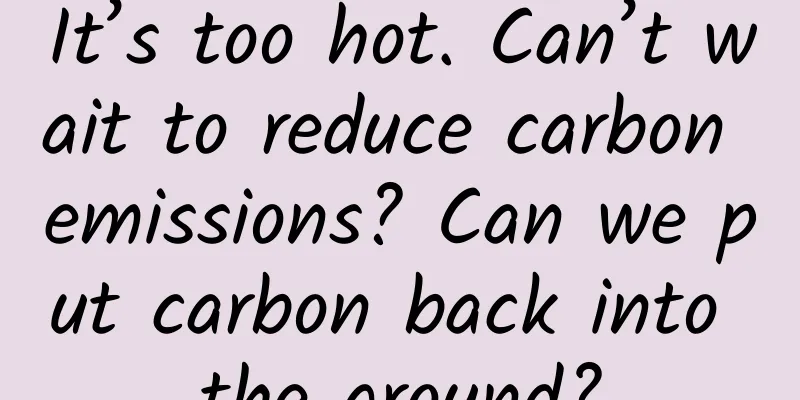It’s too hot. Can’t wait to reduce carbon emissions? Can we put carbon back into the ground?

|
Why should we care about carbon on Earth? Because carbon is ubiquitous, indispensable, and mysterious. On a carbon planet, carbon permeates life from beginning to end, and no other element is so important to us carbon-based creatures. Where did the Earth come from, and what will it eventually become? How to deal with global climate change? Carbon science may provide answers to some of humanity's biggest questions. In a sense, the story of carbon is the story of everything. This article is excerpted from "How Carbon Plays with the Earth" (Jiangsu Phoenix Science and Technology Press, July 2022 edition). The title and illustrations are added by the editor and have been edited. By Robert M. Hazen Translation | Dong Hanwen, Zeng Lingsen (Institute of Geology, Chinese Academy of Geological Sciences) Hiking through the idyllic hills of Caldara di Manziana in central Italy, surrounded by forests, flowers and the sound of birdsong, you wouldn't expect to see a death warning sign with a skull and crossbones. What does it warn of? An electric fence, a shooting range or bears? Then you come to a small valley, a lifeless depression where the bare soil contrasts sharply with the verdant uplands. What's going on? It turns out that it's all carbon dioxide. It seeps from the ground, colorless and odorless, and heavier than ordinary air, so it sinks to the ground and fills the lowest depressions. On a breezy day, this doesn't matter; the surface air currents are quickly dispersed. But on a windless day, the denser carbon dioxide replaces breathable air and causes deadly damage. Hunters are the most common victims, their dogs walking close to the ground will first face suffocation, and if the hunter rushes to his dog and kneels beside the dog regardless of the danger, he will also suffer. Carbon in circulation Carbon is mobile. It plunges from the sunlit surface into the Earth's depths as part of the shifting oceanic crust, seeps from soils as part of deep mantle fluids, and erupts from active volcanoes. Carbon atoms are precipitated from the ocean and air in solid rock and then returned to the ocean and air by weathering. Once released, carbon atoms travel around the Earth on the great ocean currents and are carried around the world by the vagaries of air currents. Living cells, from microbes to plants to humans, have long used and reused carbon atoms at a rate far greater than the rate at which carbon cycles in the nonliving world. When hot, carbon-containing magma rises from the depths, it carries the carbon dioxide with it (as mentioned earlier, hunters and their dogs occasionally suffocate to death in certain Italian mountains). As the magma rises, it affects the carbonate minerals in the rock layers, causing them to decompose at high temperatures, mixing the carbon dioxide from the mantle and crust. All of the above are part of the grand Earth carbon cycle, which creates and replenishes the atmosphere. All chemical elements on Earth cycle through cycles, and carbon is no exception. The carbon cycle is a staple of introductory textbooks and popular science websites, which often include various reservoirs of carbon atoms and the movement of carbon atoms between them. Search YouTube for “carbon cycle images” and the results will show the oceans and atmosphere, limestone and fossil fuels, animals and plants, all with little arrows indicating how carbon moves from one reservoir to another. Some diagrams also add smoking volcanoes to hint at deeper processes, but carbon deep in the Earth as the ultimate source of the atmosphere is rarely considered in detail. The reason deep carbon has been neglected is easy to understand. Compared to the rapid carbon cycle near the Earth's surface, the deep carbon cycle is very slow. It takes millions of years for a carbon atom to travel from deep into the Earth to the surface, and the details of this process are largely shrouded in mystery and uncertainty. No one knows how much carbon there is deep in the Earth, and we are not sure what different forms of carbon there are. What we know for sure is that the global carbon cycle must be a process from the atmosphere to the deep Earth and back to the atmosphere. The black basalt and other rocks that lay on the bottom of the ocean are cold and dense, denser than the hot, soft mantle below. Under the influence of gravity, huge plates of ocean crust plunge hundreds of miles downward, carrying sediments rich in carbonate minerals, basalt layers, and decomposing biological remains. This process is unstoppable, and carbon "sinks deeper and deeper" from the surface into the depths of the Earth that we can hardly reach. If surface carbon is continuously transported to the depths in this way, without additional carbon to replenish it, the carbon in the crust will be exhausted within a few hundred million years. If the surface carbon is stripped away in this way, the biosphere that depends on carbon will no longer exist. Fortunately, the carbon in the deep will gradually float to the surface. As the temperature of the subducted carbon-rich rocks rises, carbonate minerals and organic molecules begin to decompose, producing carbon dioxide and other small molecules. Some of these molecules break free from their rock "tombs" and form rising fluids that eventually return to the surface. Volcanic eruptions are the main release pathway for these deep gases. The widespread diffusion process of deep carbon escaping from the underground to the surface and diffusing into the atmosphere suggests that there is a greater carbon flux in the depths, but the specific value is difficult to quantify. Understanding the most obscure aspects of the global carbon cycle has been one of the main goals of the Deep Carbon Observatory since its inception. This work is rich and varied, with hundreds of scientists working together to solve a variety of challenging problems in dozens of field observatories and laboratories around the world. Their research on the dynamic deep carbon cycle can be summarized into three questions: How much carbon goes into the depths? What happens to carbon in the depths? How much carbon returns to the surface? Carbon balance The way human life is changing the global carbon cycle is of particular interest. For billions of years, Earth seemed to have found a balance between carbon subducted to the depths and carbon released by volcanoes, a balance that helped stabilize the climate and environment. But how stable is this ongoing carbon cycle? Nature has not dictated whether the amount of carbon that goes deep into the Earth—locked up in rocks, buried in sediments, and subducted into the mantle—is exactly equal to the amount that comes back to the surface via volcanoes and other, less violent means. But for the Deep Carbon Observatory, nothing is more important than the balance. Is the Earth's carbon cycle balanced? Mary Edmonds's research shows that many subduction zones have buried large amounts of carbon deep within the Earth. In contrast, Terry Plank argues that it is extremely difficult to store carbon through subduction and this is not a universal rule. So which theory is correct? In 2015, two visionary leaders of the Deep Carbon Observatory, Peter Kelemen of Columbia University and Craig Manning of UCLA, tried to summarize all the data in a simple deep carbon cycle diagram, like the one in a textbook. The exquisite diagram has six red arrows, each representing an important carbon flux between the surface and the deep, and next to each arrow is one or more small boxes recording the annual carbon flux in megatons. The illustration has appeared in hundreds of Deep Carbon Observatory workshops and lectures, and it has become a symbol of how much we still have to learn about carbon on Earth. Figure: Annual carbon flux between the surface and the deep ( It is important to emphasize that none of the arrows or their corresponding boxes are strictly constrained. Kelemen and Manning estimate that ridge and ocean island volcanoes emit 8-42 megatons of carbon per year, and arc volcanoes emit 18-43 megatons of carbon per year. For subducted carbon that is quickly returned to the crust and air, the lowest estimate is 14 megatons per year, and the highest estimate is up to 5 times the former. Most alarmingly, the calculations show that the net carbon flux from the surface to the deep is as high as 52 megatons, and as low as 0! We are seeing signs that Earth’s carbon balance may be changing. Our planet has cooled for more than 4 billion years, and carbonate minerals that once broke down in hot, deep environments may now be able to continue to plunge to greater depths under modern, cooler conditions. Time has also altered this inherent balance, with Earth learning new tricks to lock away carbon in black shales, shell-rich limestones, coal, and soft muds formed by the deposits of plankton remains. As climate change and ocean chemistry change, the mechanisms and rates of carbon movement are also changing. Perhaps by happy coincidence, for most of Earth’s history, the amount of carbon that was brought in through subduction was roughly balanced by the amount that was released through volcanic eruptions and other processes, so that when thick kelp mats and dense tropical forests were scavenging for carbon, there was plenty of it to support life. While the jury is still out on the carbon balance, and much work remains to be done, some scientists have come up with an important inference: the balance may have changed. Ocean sediments are holding more carbon than in most previous eras, thanks to carbonate-forming plankton. Some of this carbon may have begun its long journey into the deep mantle. As the Earth has been cooling for more than 4 billion years, the subducted carbonates don’t easily break down into carbon dioxide that can be returned to the surface via volcanic eruptions—what goes down doesn’t necessarily come up. While the exact numbers are uncertain, most calculations suggest that the rate at which surface carbon is being buried may be increasing, and that the carbon needed for life could be exhausted in just a few hundred million years. But don’t lose sleep over this, because this is only a slow change on a geological scale. What is clear is that Earth’s carbon cycle is constantly changing and will continue to surprise. This is not to say that we can ignore concerns about carbon. If you really are going to lose sleep over the changing carbon cycle, then start by focusing less on the Earth and more on ourselves. Changes in the atmosphere Carbon dioxide is an inevitable byproduct of burning anything, whether it's the famous Library of Alexandria, a patch of scrub in California, a house in Dresden, a stack of old newspapers or a Stradivarius violin. Since the Paleolithic man learned to control fire, humans have been burning fuel to warm homes, cook food and light dark paths at night. For a long time, humanity's carbon "footprint," or the net increase and decrease of carbon in the atmosphere, has been in balance. When we burn wood, we produce carbon dioxide, and when new trees grow, they consume it. The balance began to shift with the discovery of carbon-rich fuels buried deep underground. Although peat, bituminous coal, and oil had been mined in small quantities for thousands of years before the Industrial Revolution, they were not enough to significantly change the atmospheric balance. It was not until the Industrial Revolution (followed by the electrical revolution and mechanized transport revolution) that the balance really shifted. The surge in energy demand, coupled with the massive extraction of oil and coal, drove the frenzy of technological society and ushered in a wave of prosperity and material enjoyment for mankind. Over the past 200 years, we have mined hundreds of billions of tons of carbon-rich coal and oil, and the burning of these fuels currently releases about 40 billion tons of carbon dioxide into the atmosphere each year, an amount 1,000 times greater than the carbon dioxide emitted by all the world's volcanoes. Human activities have completely upset the balance of the carbon cycle. There’s no need to be ambiguous about carbon and its role in climate change; here are four facts that are indisputable. Fact 1: Carbon dioxide and methane are powerful greenhouse gases. Their molecules trap solar radiation, reducing the amount of energy that Earth radiates to space. Higher concentrations of carbon dioxide and methane in the atmosphere mean more solar energy is trapped by the atmosphere. Fact 2: The content of carbon dioxide and methane in the Earth's atmosphere is rapidly increasing. Evidence for this fact comes from different sources, among which the study of bubbles from the past trapped in the polar ice (every 1.6 km of ice core corresponds to about 1 million years) provides direct and solid evidence of changes in the present atmosphere. Over the past 1 million years, the concentration of carbon dioxide has almost always fluctuated between 0.02% and 0.028%, with the lowest values corresponding to the ice ages on Earth. In the middle of the 20th century, the value broke through 0.03%, which may be the first time in tens of millions of years. In 2015, the concentration of carbon dioxide exceeded 0.04%. Every analysis shows that this value is rising faster than at any time in millions of years. The increase in the content of methane in the atmosphere is even more significant. For 1 million years, the concentration of methane has almost always fluctuated between 4×10-7 and 7×10-7, which is also related to the arrival and departure of ice ages. Over the past 200 years, methane concentrations have increased by about 2 times, soaring to 2 × 10-6. Like carbon dioxide, methane concentrations are higher than at any time in millions of years, and are rising faster than ever before. Fact 3: Human activities, especially the burning of billions of tons of fossil fuels each year, are the primary cause of nearly all changes in the composition of the atmosphere. Fact 4: The Earth has been warming for more than a century. Records since 1880 show that the 12 hottest years have all occurred in the past 20 years. 2014 was hotter than any year in history, and the global average surface temperature in 2015 was more than 0.1 degrees Celsius higher than in 2014. 2016 hit another record high, and 2017 was almost as hot as 2016. The average temperature in the first 20 years of the 21st century was more than 1 degree Celsius higher than a century ago. Almost all scientists who have studied the above facts have reached a consensus: human activities are causing the earth to warm. This conclusion is not an opinion or speculation. It has nothing to do with politics or economics. It is not a strategy for researchers to get more funding. It is not an exaggerated news report by some environmentalists. There are some real things happening to our planet, and global warming is one of them . The doubling of atmospheric carbon in such a short period of time and the resulting global warming are unprecedented. Humanity is conducting an unplanned, unsafe geoengineering experiment, and the unintended consequences are already beginning to emerge. As carbon dioxide levels in the atmosphere have increased, so too have they in the oceans. Although the increase in ocean acidity is smaller, the change is clearly destructive because acidified waters erode carbonate shells and kill corals. Some marine biologists worry that shallow marine ecosystems around the world could collapse. The warming of the atmosphere and oceans has led to unprecedented melting of glaciers in both high-altitude mountains at mid-latitudes and in polar regions. In many coastal areas, sea level has risen significantly, perhaps by a few feet, perhaps more, but it is inevitable. Changes in ocean depth are nothing new. Over the past millions of years, Earth has experienced at least 10 ice ages, periods when as much as 5% of the Earth's water was frozen into ice sheets and glaciers, and sea levels dropped by hundreds of feet. In contrast, during periods when less than 2% of the Earth's water was frozen, sea levels rose at least 10 times, gradually approaching or slightly exceeding modern sea levels. Alarmingly, glaciers are disappearing at an unprecedented rate, and huge Antarctic ice shelves are breaking up. As more ice melts, the oceans are getting deeper, and increases of 100 feet (30.5 meters) are not unprecedented. If current trends continue, hundreds of millions of people living in coastal areas could be displaced within centuries, and some states (notably Florida and Delaware) and countries (the Netherlands, Bangladesh, and some Pacific island nations) would cease to exist. A warmer atmosphere and oceans will also affect the climate, causing changes in rainfall patterns, stronger storms and changes in the ocean currents that warm some areas and cool others. In 2017, Daniel Scott of the University of Waterloo in Ontario modeled the variable and sometimes contradictory effects of climate change on 21 former Winter Olympic sites, projecting them out to 2040. All of these venues stayed consistently cold during the 20th century, with more than 90% of winter days below freezing. But Scott’s model shows that nine snowfields, including Vancouver, Canada, Oslo, Norway and Innsbruck, Austria, will become unusable because they will spend more than a quarter of their winters above freezing. Sochi, Russia, the site of the 2014 Winter Olympics, fared the worst in Scott’s model, with temperatures expected to be above 0 degrees Celsius for more than half of the winters by 2040. The devastating effects of climate change are already being felt in ecosystems around the world, but it’s not all bad. In Greenland’s Arctic, people who for 1,000 years relied on ice fishing during cold, dark winters can now enjoy year-round open waters. In central Canada, crops are enjoying a longer growing season. An ice-free Northwest Passage between the Atlantic and Pacific Oceans could speed up global shipping. And some ice-covered rocks are being exposed for the first time ever, allowing mining companies to explore for richer ores. But other changes are truly disturbing, and they're not good for anyone. Africa's Sahara Desert is expanding rapidly, swallowing up once-stable villages. For centuries, the Arctic was too cold to harbor pests. But for the first time in history, it is experiencing swarms of mosquitoes and black flies in July and August. Ecoregions are moving north by miles each year, perhaps faster than forests, fields and migratory birds can adapt. Scientists can foresee and even mitigate many of the steady, incremental changes caused by a warming planet. But the “tipping points” that pose the greatest risk—points beyond which climate change accelerates dramatically—are harder to predict. Methane is a more potent greenhouse gas than carbon dioxide, and potentially more harmful. Almost all of the Earth’s methane is locked up in the crust, in vast methane-rich layers of ice beneath the tundra and continental shelves. While quantitative estimates are difficult, experts agree that the world’s ice contains hundreds of times more methane than all other sources and probably contains more carbon than all other fossil fuels combined. For thousands of years, methane has been a passive part of Earth’s carbon cycle, dormant and buried underground. The ultimate disaster scenario is probably a global positive feedback of methane, when the Earth's climate crosses a critical point that makes some people wake up in cold sweats at night. Warming will cause ice to melt and methane to be released, which will cause more severe warming and more large-scale ice melting. The methane content in the atmosphere may soar, and the temperature will continue to rise. We don't know if this will happen, but once this positive feedback starts, everything may be too late. We need to understand that no matter what we do to the Earth, no matter what changes may happen in the future, life will continue to exist and carbon will continue to cycle. But are we humans ready for the coming changes? Solution Humanity continues to pump an invisible, uncontrolled flood of carbon dioxide into the atmosphere, which will have effects not seen in millions of years. This is not an exaggeration, the soaring carbon dioxide levels are not deceiving, and the consequences are happening. Those who deny this fact are either ignorant, greedy, or both. What should we do as individuals? Leading a carbon-neutral life is a daunting challenge in this era, as carbon emissions permeate society and hinder the realization of many of our best wishes. Would you build a huge wind turbine for "clean" energy? In the process, you would probably need to cut down a lot of vegetation and pour concrete for the foundation, which emits a lot of carbon dioxide during the production process. Would you drive an electric car? The electricity would probably come from a power plant that uses fossil fuels. Taking advantage of public transportation and organic farming, using recycled aluminum and cloth diapers, all of these actions can effectively reduce energy consumption, but they still rely on carbon-based fuels to some extent. Whether you live in a city or on a farm, or anywhere in between, you are likely a net producer of greenhouse gases. Scientists tend to be optimists. Although the global changes mentioned above may bring unexpected disasters, we are still looking for solutions and see some opportunities. Peter Kelemen is such an optimist. Kelemen works at Columbia University's famous Lamont-Doherty Earth Observatory. The observatory is located on the famous basalt cliffs in the Palisades area near the Hudson River, just across the bank from Columbia University's main campus in Manhattan. It is a good place to study the earth's rocks, oceans and atmosphere. Despite the spectacular rock formations before him, Kelleman’s eyes were set on the majestic mountains of Oman, a faraway Arabian peninsula where the sun-baked earth reaches 60 degrees Celsius much of the year. There, Kelleman studied some of the most bizarre rocks on Earth: ophiolites, giant blocks of mantle rock that should be buried dozens of miles below but have somehow appeared on mountaintops 10,000 feet high. At first glance, Kelemen is an easygoing guy. He has a soft, slightly graying beard, and whenever he meets old friends or new ones, he smiles, shakes your hand, and speaks in a soothing, relaxed tone. He has a laid-back vibe, and you'd want to take a long walk with him. First impressions can be misleading, though. Geological work in Oman is not for the casual geologist. The culture is welcoming to a certain extent, but field work there is not so easy, because the work seems to be somewhat invasive. They are hostile to foreigners rubbing their land. And Kellemen wants more than just to knock a few rocks off a roadside outcrop; he wants to drill to get cores from thousands of feet below. So there are understandable delays and obstacles to working here. Researchers must obtain permits from the land, water, and mines departments, and they must hire local Omani drilling companies and pay the corresponding fees. And because no one has ever drilled in these ophiolite mountains, new research may require new regulations, but no authority seems to be sure yet. Delays meant work was in limbo, field trips were put on hold, and travel plans were canceled. Given these administrative hurdles, many scientists would have given up on conducting research here. But Kellemen had determination, drive, and what seemed to outsiders to be infinite patience and calm. After many years of waiting, the Oman drilling project finally got underway, with historic results. Kelemen's study reconfirms what we already know: Oman's ophiolite mountains were formed when mantle rocks were thrust up onto shallower basaltic oceanic crust by plate tectonics. These mantle rocks are rich in magnesium and calcium but low in silicon, and when exposed to the Earth's atmosphere, they react quickly with carbon dioxide to form crisscrossing white veins of magnesium and calcium carbonate . The carbonate minerals form at an astonishing rate, Kelemen and his colleagues found. Ophiolites suck carbon dioxide from the air and form new carbonate minerals at an extremely fast rate. You can even see crystals forming and growing in ponds or pools when mineral-rich groundwater seeps from the outcrops. Unlike many minerals that can only form quickly at high temperatures deep in the Earth, ophiolites can form at room temperature, which is admittedly much hotter than your living room on average. These new minerals take up a larger volume than the original ones, expanding the formation. This may explain why Oman's mountains are still rising by several millimeters per year, despite the fact that there is almost no local seismic activity. Kelemen's mind was waking up to the following conclusion: Ophiolites are constantly consuming CO2 . Oman has enough ophiolites to store all the CO2 produced by humans for hundreds of years. For now, the Omani government doesn't want to participate in the storage plan - the country's economy is based on oil, not carbon storage. But these rocks are not going away, and the prospect of them contributing to solving the earth's carbon crisis remains. Peter Kelemen is a patient optimist . Translator’s introduction: What kind of book is “How Carbon Runs the Earth”? Written by Dong Hanwen In the summer of 2021, I suddenly received an invitation from Jiangsu Phoenix Science and Technology Publishing House to translate a popular science book about carbon, Symphony in C: Carbon and the Evolution of (Almost) Everything. I was very nervous and terrified. But when I learned that the author of the book was geologist Robert Hazen, I was ecstatic. Robert Hazen is a great geologist whom I have admired for a long time. Hazen is a senior fellow at the Carnegie Institution of the United States, a professor of earth sciences at George Mason University, and a former president of the Mineralogical Society of America. He is also the chief researcher of the Deep Carbon Observatory (DCO). Hazen received a bachelor's and master's degree in geology from the Massachusetts Institute of Technology and a doctorate in earth sciences from Harvard University. Hazen is a very prolific geologist. So far, he has published more than 400 articles and 25 books, including many best-selling popular science books. In particular, the book "The Story of the Earth" (or "The Thousand Faces of the Earth") deeply attracted me. I used it as my bedside reading, read it many times, and recommended it to many friends. Hazen is very keen on communicating science to the public, and in various forms, such as radio, television, public lectures and video courses, for which he has won the Mineralogical Society of America Award and its Outstanding Public Communication Award. "What an honor it is to be able to translate Hassan's book!" I thought to myself. Thinking of this, I gladly accepted the invitation without much hesitation. Translator Dong Hanwen connects with author Robert Hasen (Photo provided by the author) The book is part of the Deep Carbon Observatory (DCO) project, funded by the Sloan Foundation, of which Hazen serves as chief scientist. The project aims to bring together scientists from different fields around the world to solve the mysteries of carbon on Earth. In this book, Hasson skillfully combines his understanding of carbon science with an orchestral background, and cleverly arranges the whole book. In order to build a coherent framework, he thought of the ancient Greek "four elements" about the material composition of the world, namely earth, air, fire and water. Each element has its own characteristics, each is an indispensable part of the universe, but all are the source of all material creation. Among the atoms in the periodic table, only carbon shows different characteristics from the four classic elements of "earth, air, fire and water", providing a "four-movement" framework for the whole book. Like a symphony, the four movements of this book are different in theme, emotion and rhythm. The first movement, "Earth Movement: Carbon in Crystals," identifies minerals and rocks as the solid crystalline foundation of the Earth. This movement began at the beginning of creation, long before the Earth was formed, when carbon atoms were synthesized from smaller "fragments." Then mineral deposits began to appear and evolve on Earth, representing the growing diversity and abundance of carbon-containing compounds in crystalline form. The second movement, “Air Movement: Carbon in Cycle,” focuses on Earth’s magnificent carbon cycle. Carbon atoms are constantly moving between reservoirs—exchanging places between the ocean and the atmosphere, entering the Earth’s interior through plate tectonics, and returning to the surface through hot gases released by hundreds of active volcanoes. For millions of years, this deep carbon cycle has maintained a stable balance, but human activities may be changing this balance, with unexpected consequences. The third movement, “Fire Movement: Carbon in Materials”, tells the story of carbon’s active role in energy, industry and emerging high-tech fields. Carbon is a constituent element of many materials with countless different properties and runs through our daily lives. Finally, the fourth movement, “The Movement of Water: Carbon in Life,” explores the origin and evolution of life, bringing together many themes in carbon science. Special Tips 1. Go to the "Featured Column" at the bottom of the menu of the "Fanpu" WeChat public account to read a series of popular science articles on different topics. 2. Fanpu provides a function to search articles by month. Follow the official account and reply with the four-digit year + month, such as "1903", to get the article index for March 2019, and so on. Copyright statement: Personal forwarding is welcome. Any form of media or organization is not allowed to reprint or excerpt without authorization. For reprint authorization, please contact the backstage of the "Fanpu" WeChat public account. The cover of this article is from the copyright gallery and is not authorized for reproduction. |
>>: Heartbroken! my country's longest existing wooden arch bridge caught fire. Can it be rebuilt?
Recommend
How to build a user operation system?
Whether it is offline training or online classes,...
Only 5% of Android phone users plan to switch to iPhone 6
According to technology blog CNET, Apple's ne...
Why does iPhone 6 insist on 1GB of memory?
This question is both simple and complex. Someone...
Miao Sang's iPad illustration system class for beginners will end in July 2021
Miao Sang's iPad illustration system class fo...
Big data interprets new trends in Apple App Store
This article mainly interprets the new trends of ...
Zhang Xiaolong: Get out of loneliness
[[127969]] Today, as the commercial value of WeCh...
What are the functions of the Lanzhou WeChat beauty mini program? How much does it cost to develop a skin care product mini program?
The most profitable industry nowadays is the &quo...
When is the healthiest time to eat apples? What does the research say?
Apple is a fruit known for its health benefits, a...
Refuse to steal your iPhone passwords! 6 practical tips to create a more secure iPhone password library
Mobile payment and online payment are becoming mo...
Carcinogenic? Loss of nutrients? Air fryers are in trouble...
◎ Comprehensive report by Wang Yu of Science and ...
Sony PS 5 is in short supply, and the console King of Glory is expected to sell more than 300 million units in the end
A digital product that is not a financial product...
Self-driving cars become vending machines? Smart cars open up a new shopping platform
In-car commerce startups such as Cargo and Vendy ...
iOS 19 leaks are here, and the first new feature is exposed!
Although the official version of iOS 18 has only ...
Autohome Live Broadcast: Zhang Zhaozhong, the "Director" of the Beijing Auto Show, makes a surprise visit
The 2018 Beijing International Auto Show is worth...
Private domain traffic contact marketing strategy!
The upper limit of WeChat enterprise groups has b...









